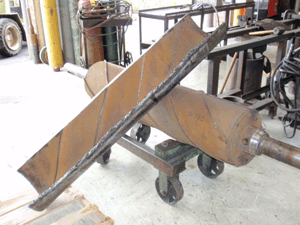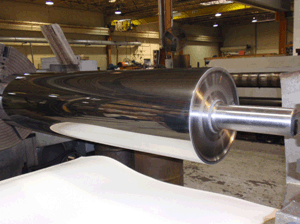Roller Refurbishing: Replace or Refinish?
- Published: April 01, 2010, By By Matthew Menges, Menges Roller Co.
Due to the long service life of most heat transfer rolls, converters often wait for problems to arise before servicing their equipment. Unfortunately, that puts them at a loss to understand why their rollers are losing efficiency, which may require the production line to run at a lower speed to achieve the correct processing temperature.
Considering the priority to keep production going, converters should ask: Can the roll be repaired or refurbished, or is it necessary to have a new one fabricated? If you deal with an expert, and your damaged roll is not a “basket case,” there is a good chance that repairing or refurbishing can provide good-as-new performance while saving considerable time and money.
After years of service, the inside of your heat transfer rolls begin to look like the inside of the radiator on an old pickup truck. And no wonder. The rolls are going through stresses that are very similar to those of a radiator. The rollers conduct heat transfer, either pulling heat out of your substrate or putting it in.
If the process water in your roll, like the coolant in your radiator, isn't tested frequently to ensure it is at the correct level to resist oxidation, improper pH, and contaminants, the inside of those rolls will corrode and degrade heat transfer efficiency.

Converters often claim their rolls have a blockage that inhibits the flow of process fluids, which is critical to the roll's heating or chilling performance. When the process begins to suffer, operators will ask the roll supplier how quickly a new roll can be made.
Unfortunately, in many instances, fabricating the new roll will take many weeks. The delay may be worsened because the original roll drawings aren't available or the OEM won't release them.
In these cases, the process operator or maintenance manager may want to consider having a roll refurbished. That may be a very practical alternative to having a new roll built.
Either way, the roll manufacturer must have the capability of reverse-engineering the worn roll during the disassembly process. To facilitate this process, their machinists will produce detailed drawings that can be used to accurately refurbish the existing roll or fabricate a replacement.
It is very beneficial, particularly with older roll designs, to have engineers create CAD drawings to prove the design accuracy for repairing a roll. Then design improvements can be incorporated. These new drawings will expedite the fabrication of a replacement roll, if needed, and provide the drawings necessary for future reference.
Most operations understand what they want heat transfer rollers to do to their web. Yet they don't realize the engineering expertise needed to achieve optimum performance, particularly when it comes to the choice of refurbishing or sourcing replacement rolls.

Given the complexities, converters rely on their roll supplier to handle all the calculations of flow rate, BTU output and input, deflection, pressure testing, and roll balance. And the roll finish is certainly a specialty, whether plasma, high-velocity oxygen fuel (HVOF), chrome, rubber, or urethane.
In the end, of course, the customer is mostly concerned about keeping production going, and that means getting fast service, whether replacing or refurbishing their rollers.
Supplier Info
Menges Roller Co. | www.mengesroller.com
Circle 308 or visit www.freeproductinfo.net/pff
Matthew Menges is president of Menges Roller Co., Wauconda, IL. He has been in the roller industry for 26 years. Matt spends most of his time in the field working to find solutions for his customers. Contact him at 847-487-8877; This email address is being protected from spambots. You need JavaScript enabled to view it..
A Case for Refurbishing
Brian Varley, plant engineer at Sonoco Clear Pack, Franklin Park, IL, needed to repair or replace one of the large heat transfer rolls at the firm's sheet extrusion operation. “The shell surface on one of our tungsten carbide rolls was excessively porous,” Varley explains, “so it would not accept replacement tungsten carbide well enough and would not polish properly.”
Even with laser welding, the roll supplier determined that the super-finish required for application could not be achieved. “They removed the outer shell, installed a new one, and applied the tungsten carbide super finish to the roll,” Varley says. “However, once they removed the shell, they found a number of other problems in the roll's internals. There were some leaks that they were able to repair, and they also rebalanced the roll. After the refurbishing, which was done fairly quickly by Menges Roller, we had a virtually brand-new roll for less than half the price of fabricating a complete replacement.”
Varley recalls an earlier instance in his career for a previous employer when there was a complete blockage of a roll that ran in a fleet of 25 large, rubber-covered heat transfer rollers used in the production of cast film. The roll had been in service for more than 20 years.
“A new roll core like this was in the $40,000 price range,” says Varley. “Plus, of course, there was the substantial added cost of downtime.” The roll was repaired for less than 40% of that cost. He reports the outer shell was replaced, the internals machined to remove oxidation, and the internal shell was rewound to produce an even better cooling rate than when the roll was new.
“The turnaround time for refurbishing may be much shorter than making a new roll,” says Varley. “With new rolls you get in line with a lot of other customers, which can result in downtime as well as high replacement roller costs. Fortunately, there are suppliers that have a lot of OEM experience but are also very capable of repairing failure problems. And that allows us to make the best choice for our situation.”
The views and opinions expressed in Technical Reports are those of the author(s), not those of the editors of PFFC. Please address comments to the author(s).




